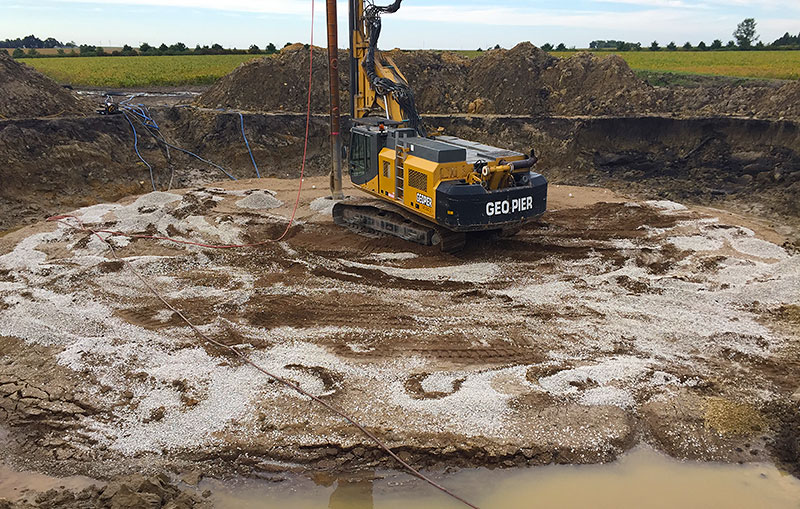Managing Groundwater Levels Before, During and After Ground Improvement


Richard Gernant, P.E., our lead Geopier® design engineer in Iowa, shares methods for managing high groundwater levels, which include ground improvement elements built with open-graded or free-draining aggregate materials.
Dewatering, also known as construction dewatering, is the process of removing groundwater or surface water from a construction site. It is usually done before excavation for footings, which helps to lower the water table and provide a dry and stable working environment. But this is just one part of the construction planning equation for projects with high groundwater levels or poor soil conditions.
In areas with shallow groundwater levels, like many areas of Iowa, water levels can be expected between three and five feet from the surface. However, there may also be the potential for high-water levels or perched water conditions during seasonal fluctuations or abnormally heavy rains. In other states, different soil conditions such as clay soils layered with water-bearing sand seams or pockets, can also create risks of unexpected water seepage.
We design our ground improvement solutions based on the high-water level noted in the geotechnical site analysis rather than observed groundwater conditions at the time of bore hole measurements or cone penetrometer testing. The overall geotechnical design and construction plan should take into consideration other methods to manage seepage before, during and after ground improvement.
Here are additional methods to consider for the long-term stability of your foundation.
Using Open-Graded Aggregate
In many cases, even when installing reinforcing elements below groundwater levels, Geopier reinforcing elements can be constructed quickly with very little influence of water infiltration during installation. However, in some water-bearing soils, temporary casing can be used to control water inflow until the piers are in place.
Once installed, the elements will perform as intended. However in some cases water can’t be controlled by casing or there can be a risk of seepage through the Geopier reinforcing elements. We can solve this concern with Geopier elements built with open-graded or free-draining aggregate materials, which are just as strong and allow water to flow on its normal course.
Reducing Upward Pressure
This solution of open-graded aggregate also helps manage the risk of upward pressure and seepage that can loosen densely compacted aggregate in the upper portion of the piers and weaken the matrix soils. It is the simplest method for helping to maintain the subgrade for foundation pad construction.
Now, if piers are constructed with well-graded or less permeable aggregate material, and the site experiences upward pressure and hydraulic flow, the contractor can remediate the issue by removing the upper six to 12 inches of well-graded material and replacing it with open-graded material. It is an extra step the contractor will have to go through, but in most cases this will stabilize the surface prior to construction of the foundation pad.
Installing Mud Mats
Another issue with foundation construction is continuous water seepage into the excavation site, which may be left open to the elements for several days or a week. In addition to dewatering, a successful method for protecting the subgrade during foundation pad construction is to install a mud mat, which is basically concrete slurry on the order of 2 to 4 inches thick. A mud mat will protect the reinforced foundation soils from surface water and creates a good working surface for foundation pad installation.
It is important to get your mud mat in place as soon as possible after excavation to the foundation subgrade to avoid surface rains or seepage that can soften the bearing soils reinforced by the ground improvement. If the mud mat is not installed in a timely manner and water ponds in the excavation, it may require removal of six to eight inches of subgrade and replacement with open-graded materials and/or a thicker mud mat.
Trenching and Pumping
As a further best practice to retain a dry excavation site, especially when water has a high potential to flow into the excavation, a trench may be placed around the perimeter of the pad site with pumping to divert water until the foundation is constructed.
Once the pad is constructed, with proper backfilling and compaction, then groundwater can stabilize at normal levels with little if any future effects on foundation performance.
Some or all of the methods we’ve listed here can be considered and implemented to obtain a competent, reinforced soil. You can improve the long-term performance of your project regardless of water levels.
Visit this page to learn how we support design teams with ground improvement design and engineering.
